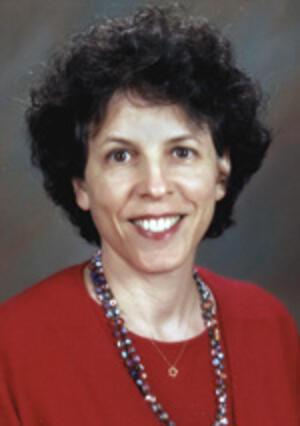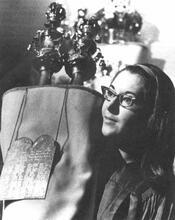Laura Geller
One of the first women to be ordained as a rabbi in the United States—and the first working rabbi to bear a child—Laura Geller has played an important role in encouraging a higher degree of both tradition and egalitarianism within the Reform Jewish community.
Institution: Rabbi Laura Geller, Beverly Hills, California.
Rabbi Laura Geller has repeatedly challenged exclusions, showing that women’s leadership could bring forth more meaningful experiences of Judaism. As a lone woman rabbinical student among men classmates and teachers in the early 1970s and after she was ordained in 1976, she came to see that women rabbis could offer all congregants a different relationship to the sacred, opening new possibilities in Jewish life. As a leader at the University of Southern California Hillel the American Jewish Committee, Temple Emanuel of Beverly Hills, and ChaiVillageLA, all in Los Angeles, Geller showed the possibilities of women’s leadership. Throughout her career, she has identified areas where American Jews could do better and has stepped in to show that it could be done.
Among the few women rabbis ordained during the 1970s, Laura Geller has been most prominent in shaping the impact of female religious leadership upon Judaism.
Family and Early Life
The second of three children, Geller was born on April 21, 1950, the only daughter of Leonard (b. 1921) and Rosalie (Cohen) Geller (b. 1921). Her siblings are Roger (b. 1946) and Michael (b. 1951). The family resided in Brookline, Massachusetts, until they moved to New York City when Geller was fifteen. Leonard, a graduate of Brown University, worked in the shoe business. Rosalie, who did not receive a college education, was active as a volunteer and professional worker for AFS (American Field Service), facilitating intercultural exchanges between American and international high school students.
After graduating from the Dalton School, Geller matriculated at Brown University in 1967, where a number of experiences shaped her path toward the rabbinate. Immersion in the Christian-oriented civil rights movement convinced her to seek an activist path within her own spiritual tradition, and six months on an Israeli A voluntary collective community, mainly agricultural, in which there is no private wealth and which is responsible for all the needs of its members and their families.kibbutz pushed her to challenge a claim she heard there—that authentic Jewish identity was impossible outside of Israel.
Becoming a Rabbi
Although engaged in the emerging feminist movement, when she applied to Hebrew Union College-Jewish Institute of Religion (HUC-JIR), the Reform rabbinical school, in 1970, Geller was not yet attuned to the significance of women’s traditional exclusion from the rabbinate. Nor was she aware that Sally Priesand was on course to become the first woman ordained by a rabbinical seminary in 1972.
As the only woman among 50 first-year rabbinical students in Jerusalem, Geller found community and studied not with her classmates, but rather with their wives. Geller remained isolated as a woman in rabbinical school until, returning to New York for her final year of study after two years at HUC-JIR’s Los Angeles campus, she found a handful of female students enrolled in the classes below her.
Two ideas central to Geller’s rabbinate and published writing arose early in her career. In response to a professor’s claim that “there is no important moment in the lifetime of a Jew for which there is no blessing,” Geller recognized the necessity of creating rituals that could address the many stages of women’s lives overlooked by Judaism’s male-centered tradition. Later, the response she received as a new rabbi helped her see that women rabbis could offer congregants a different relationship to the sacred, opening new realms and possibilities in Jewish life.
Pioneering Professional
Rewarding internships at Vassar and UCLA during Geller’s rabbinical training confirmed her desire to work in a university setting. In 1976, after becoming the third woman ordained within the Reform movement, Geller took a position as director at the University of Southern California Hillel, arriving with a high public profile as the first woman rabbi on the West Coast. Geller worked actively with all segments of the USC community. The Jewish women’s faculty group that she founded took an activist role on campus, leading, for example, a successful drive that ended USC’s practice of paying membership fees for university administrators at private clubs that excluded women and minorities. Geller also organized a Jewish Women’s Research Group, where a number of male and female Jewish studies scholars made their first forays into the emerging field of women’s studies.
From 1990 to 1994 Geller worked as director of the American Jewish Congress branch in Los Angeles. Drawn by the challenges brought forth in the wake of the Rodney King riots, Geller saw this role as an opportunity to introduce a progressive Jewish voice into the city’s political discourse. She initiated the establishment of a Jewish Urban Center to explore the Jewish stake in Los Angeles politics and life. She also created the Jewish Feminist Center to capture the energy feminism was bringing to Judaism by organizing resources and classes and facilitating public Lit. "order." The regimen of rituals, songs and textual readings performed in a specific order on the first two nights (in Israel, on the first night) of Passover.seders for women during A seven-day festival to commemorate the Exodus from Egypt (eight days outside Israel) beginning on the 15th day of the Hebrew month of Nissan. Also called the "Festival of Mazzot"; the "Festival of Spring"; Pesah.Passover.
In 1993 Geller offered a challenging address at a symposium convened to mark the twentieth anniversary of Sally Priesand’s ordination. She questioned why it was that so few women had advanced to positions of prominence within the Reform movement and the prevailing explanation that women simply chose to have an impact in smaller spheres. Geller pointed out that the striking differences in the career paths and salaries of women and men ordained at the same time reflected more than personal choice. She argued that Reform Judaism had to confront the structural factors that favored men and impeded women.
Taking up her own challenge, Geller in 1994 became the first female HUC-JIR graduate hired through a national search to lead a major metropolitan synagogue, Temple Emanuel of Beverly Hills, California. Beyond her own pulpit, Geller continued to define the fourth decade of leadership by Reform women rabbis. In 2001, she was appointed to the HUC-JIR Board of Governors. She also chaired a committee that selected Rabbi Janet Marder (b. 1954) as president of the Central Conference of American Rabbis for a two-year term, making Marder, in 2003, the first woman to lead one of the movement’s governing bodies. Geller also served on the editorial board of and contributed two articles to The Torah: A Women’s Commentary, published under the auspices of Women of Reform Judaism in 2007.
Geller’s career has been shaped by a deepening spirituality and personal relationship to God. She sees herself as part of a growing embrace of tradition within the Reform movement that women rabbis have helped to shape by encouraging all Jews to think about their lives in the context of Jewish tradition, text, and ritual.
Geller has also been a pioneer in negotiating the distinctive challenges women rabbis have faced in integrating their personal and professional lives. Her son Joshua was born in 1982 and her daughter Elana in 1988. Her first two marriages, in 1978 and 1994, ended in divorce. Her 2003 marriage to Richard Siegel (1947-2018) resulted in an important professional and personal partnership and contributed to the next phase of Geller’s leadership. Siegel, co-author of the ground-breaking First Jewish Catalogue (1973), served as executive director of the National Foundation for Jewish Culture from 1978 through 2006. When he eventually moved to Los Angeles to join Geller, he served as executive director of HUC-JIR’s Zelikow School for Nonprofit Management (endowed and rebranded under his leadership) from 2007 through 2015.
It Takes a Village
As Geller approached her 2016 retirement, she began to explore what she saw as the challenge facing her and many in her community in their next phase of life. In noticing many of her age-mate baby boomers leaving the congregation, she questioned why the synagogue was not meeting the needs of members who were moving into what she identified as an emerging new stage of life between midlife and frail old age. As part of a listening campaign, she identified shared needs related to spirituality, health, finance, and community.
As so often in Geller’s career, considered inquiry led to action. This time, she took on the challenge of helping to create a more meaningful post-retirement experience through two endeavors. In her congregational role, she initiated a partnership with another local congregation, Temple Isaiah, to create the first synagogue-based version of the national Village movement, through which a regionally based group of active older adults commits to helping members age in place. Geller and Siegel put together a successful proposal that yielded a grant from the Jewish Community Foundation of Los Angeles to create ChaiVillageLA, which officially launched in 2017.
By 2019, ChaiVillageLA claimed 230 members, about half from each synagogue. When COVID-19 hit in 2020, the mutual support that ChaiVillagers drew from their socially distanced peers, along with professional support offered by the organization’s executive director, proved vital in ways that could not have been anticipated when the Village was created. Members found the Village to be a “life-saving” antidote to the loneliness and isolation so many were experiencing. The success of ChaiVillageLA led Geller, in 2019, to create the Synagogue ViIlage Network (SVN), through which she works with synagogues around the country to explore the village model for themselves. In its first few years, SVN’s work with five synagogues in Los Angeles and four in Long Island led to the creation of six new villages.
Geller’s other major effort, created in partnership with her husband, was a book project that put the learnings from ChaiVillageLA into a format that echoed Siegel’s earlier landmark work in the Jewish Catalog. Drawing upon their own experiences and professional networks developed over lifetimes devoted to Jewish spiritual community and practice, Geller, Seigel, and an impressive roster of contributors reframed the experience of aging from one of decline to one of opportunity, with a focus on learning, giving back, and connecting. When Siegel passed away from cancer in 2018, Geller was determined to keep her word to him to finish the project they had started together. Getting Good at Getting Older was published by Behrman House at the end of 2019; pioneering again, Geller soon found herself conducting a book tour via Zoom all over the world.
As Geller focuses on reframing the paradigm of aging from one of loss to one of opportunity, she continues to lead as a respected and courageous voice for women and men in Judaism, always articulating the questions and meeting the challenges that have emerged over her almost fifty years of growth and leadership in Jewish life.
Selected Works by Laura Geller
Getting Good at Getting Older, with Richard Siegel. Millburn, NJ: Behrman House, 2019.
“Encountering the Divine Presence.” In Four Centuries of Jewish Women’s Spirituality: A Sourcebook, edited by Ellen Umansky and Dianne Ashton, 242–247. Boston: Beacon Press, 1992.
“From Equality to Transformation.” In Gender and Judaism, edited by T. M. Rudavsky, 246–251. New York: New York University Press, 1995.
“My Search for God,” “Reactions to a Woman Rabbi.” In On Being a Jewish Feminist, edited by Susannah Heschel, 210–213. New York: Schocken Books, 1983.
“The Torah of Our Lives.” In Beginning Anew: A Woman’s Companion to the High Holy Days, edited by Gail Twersky Reimer and Judith A. Kates, 258–264. New York: Touchstone, 1997.
"Rediscovering Regina Jonas: The First Woman Rabbi" and "Women Rabbis and Feminism: On Our Way to the Promised Land.” In The Sacred Calling: Four Decades of Women in the Rabbinate, edited by Rebecca Einstein Schorr and Alysa Mendelson Graf, 45-50, 355-365. New York: CCAR Press, 2016.
Other sources: www.chaivillagela.org, synagoguevillagenetwork.org




